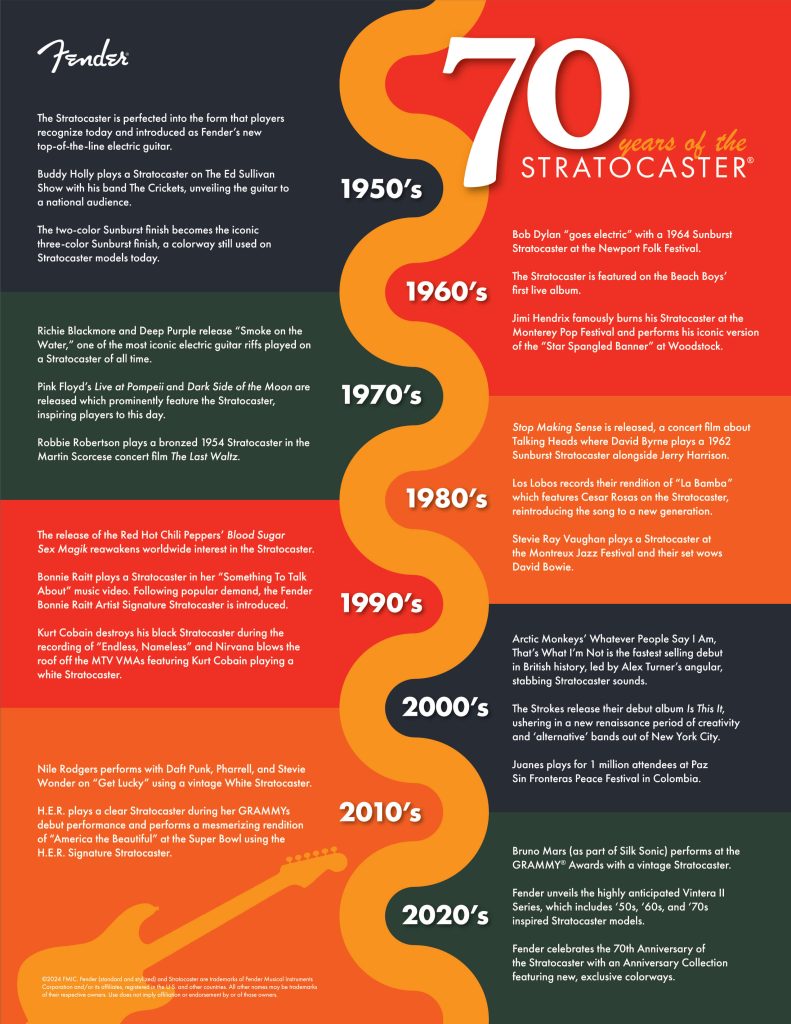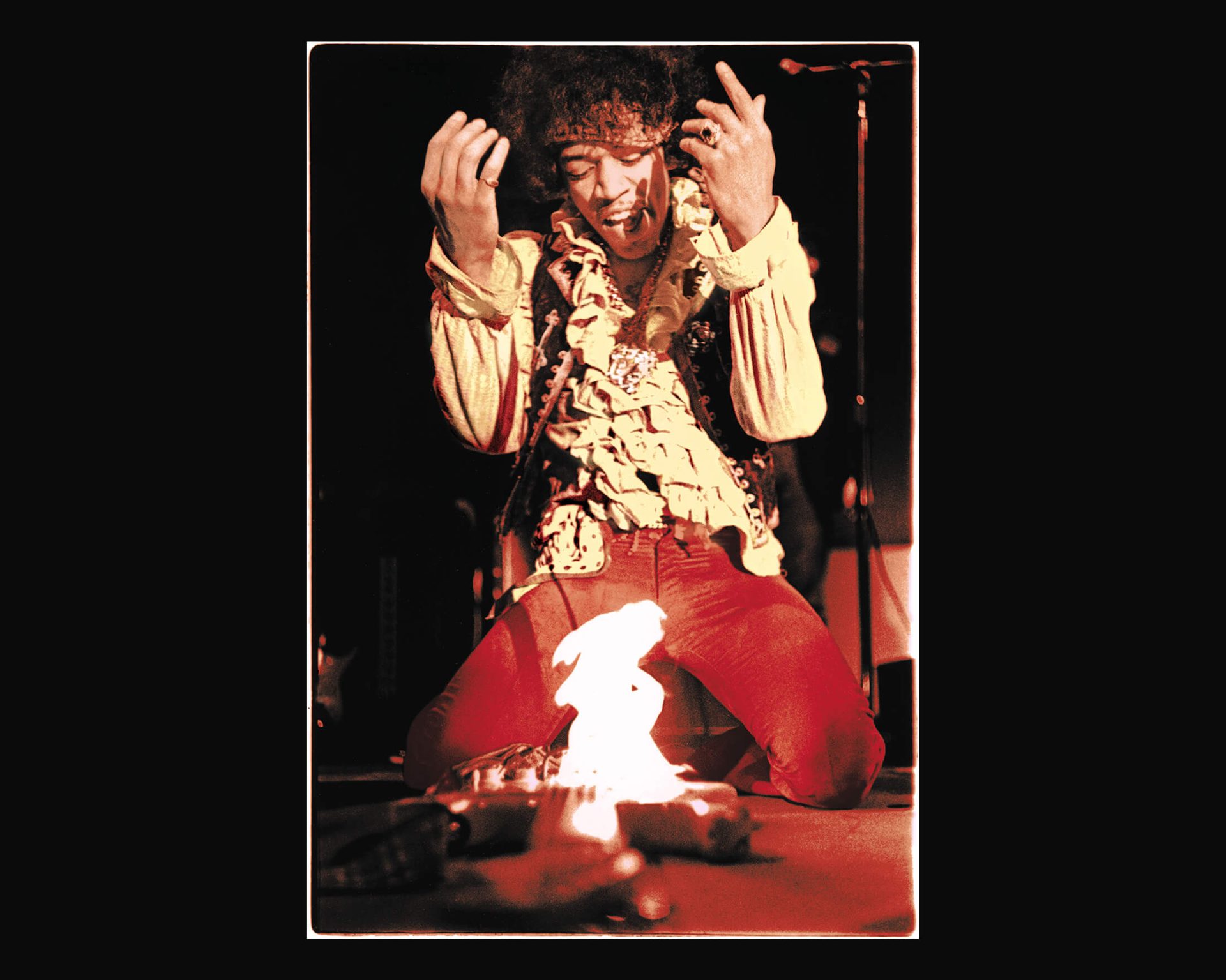After a Rocky Start, the Fender Stratocaster Has Remained on a Consistently Upward Arc
by Jon Wiederhorn
Years before the iconic Ed Sullivan Show helped turn stars like The Beatles, James Brown, The Rolling Stones, and The Doors into mainstream rock stars in America, the legendary variety program served as a launching pad for a future rock star and his eye-catching guitar. It was 1957. Just a year before, Elvis Presley continued his swagger through the homes of American TV viewers with three booked segments, which propelled his nationwide domination. But Elvis played a large-body acoustic Gibson J-200, which didn’t do much to pique the interest of the guitar community; everyone was way more tapped into his stage charisma and overt sexuality than his choice of instrument.
A little more than a year later, American rock band The Crickets performed on Sullivan’s show on December 1, 1957, and 21-year-old frontman, Charles Hardin “Buddy” Holly, donned glasses and a previously obscure Fender Stratocaster, as he and his bandmates performed the songs “That’ll Be The Day” and “Peggy Sue.” As tight and impressive as the performance was, it was Holly’s guitar that captured the attention of a burgeoning guitar nation. The instrument, which was released three years earlier, suddenly started turning heads and approaching sales of the previously more popular Gibson Les Paul and Fender Telecaster.
“When it first hit the scene in the 50s, people viewed it like a space vehicle, almost,” says Fender Director Allen Abbassi, as Fender ramps up the 70th Anniversary celebration of the Stratocaster. “It had those curves and the horns, and the six on the side tuners. It looked like nothing else at the time.”
“I used to ride the bus downtown and look in the music store window at the Stratocaster for months before I had one,” says Jimmie Vaughan. “For me, it’s a rocket to outer space, it’s my favorite guitar.”
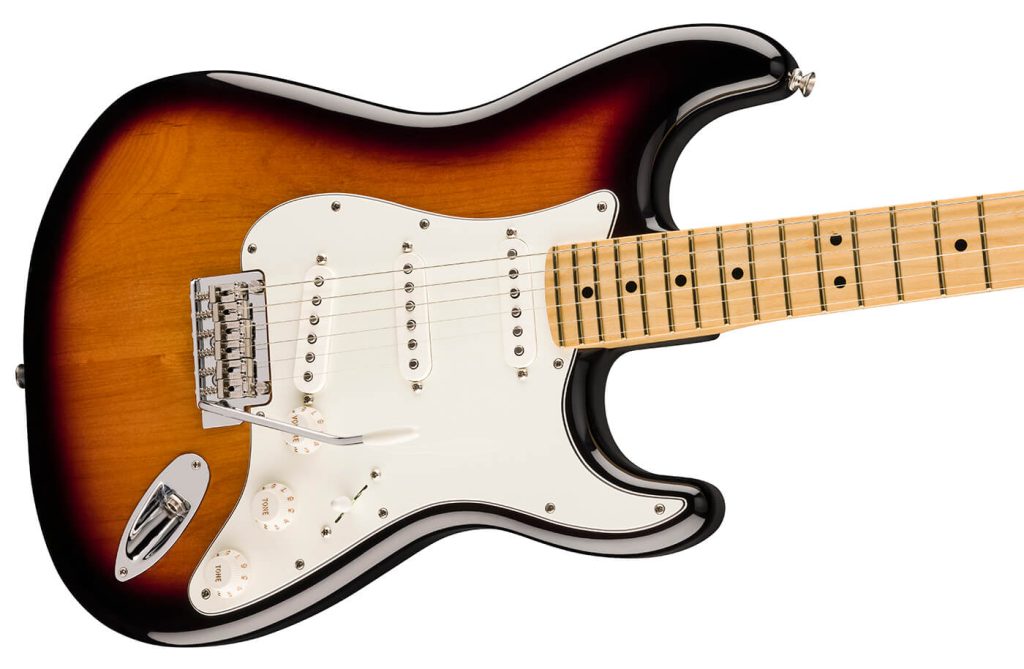
As with other Fender guitar designs, the Stratocaster was meant to emulate, modify, and modernize company founder Leo Fender’s previous offerings. Fender consulted numerous designers and musicians to determine the specs for the Stratocaster. The revolutionary body was modeled after the Fender P-Bass, which hit the market in 1951. As with that instrument, the two horns were intriguing, and their appeal went beyond mere aesthetics. They helped balance the weight of the guitar and allowed players easier access to the higher frets.
“Leo considered the Strat to be a direct evolution of the Telecaster [which also came out in 1951], “Abbassi says. “The Telecaster has a slab body and a lot of the artists that were using the instruments at the time said, ‘Hey, it kind of digs into my torso when I’m playing. It’s uncomfortable.’ That was the impetus for designing the belly cut to make it feel better against the body.”
In addition to making the Stratocaster sleeker and easier to play than other guitars, Fender wanted it to sound better. So, he used three single coil pickups in the guitar, and simple-to-use three-position-selector that, in a fluke of good fortune, could be positioned between the first-and-second and second-and-third settings, providing players with five sound options (the bridge pickup, the middle pickup, the neck pickup, the bridge and middle pickup, and the middle and neck pickup).
“The Strat allows the expressiveness of an artist and that unique voice to really come through more than most other electric instruments,” explains Abbassi. “If you listen to some of the greats — like David Gilmour, Jimi Hendrix, Stevie Ray Vaughan, or Mark Knopfler – you can instantly tell they’re playing a Strat. You can hear those beautiful bell-loke tonal qualities, but you also instantly know who’s playing.”
“I got my Stratocaster in 1973 when I realized that it was what my sound was missing,” adds Nile Rodgers. “And once I did…it changed my life 1000%. I have been able to write the jazz influenced dance-disco funk pop songs that people have loved for decades as well as rock, country, folk and EDM collaborations thanks to my Strat.”
Fender further prospered by making the guitar easy to customize. Through the decades, different players have found ways to modify the Stratocaster into the ideal vehicle for their chosen sound. Vaughan’s “Number One Strat,” for example, featured a 1963 body, a 1962 neck, and was fitted with standard 1959 single coil Strat pickups. In 1968, Jimi Hendrix’s tech Roger Mayer refit the legendary guitarist’s white Strat with early ‘60s single coil pickups that had been hand-wound by Seymour W. Duncan, who handed them to Jimi in as small bag. Decades later, Iron Maiden guitarist Dave Murray bought Free guitarist Paul Kossoff’s Strat in 1976 the year after the guitarist died, replaced the pickups with DiMarzio humbuckers and used it on the band’s first eight albums.
“The Strat is one of the most customizable instruments and that’s an outgrowth of the fact that Leo wanted to produce a guitar that was easy to manufacture, easy to repair, easy to maintain,” Abbassi says. “With the turn of a few screws, you can replace the pick guard, the pickups, the neck. People love to customize the instrument.”
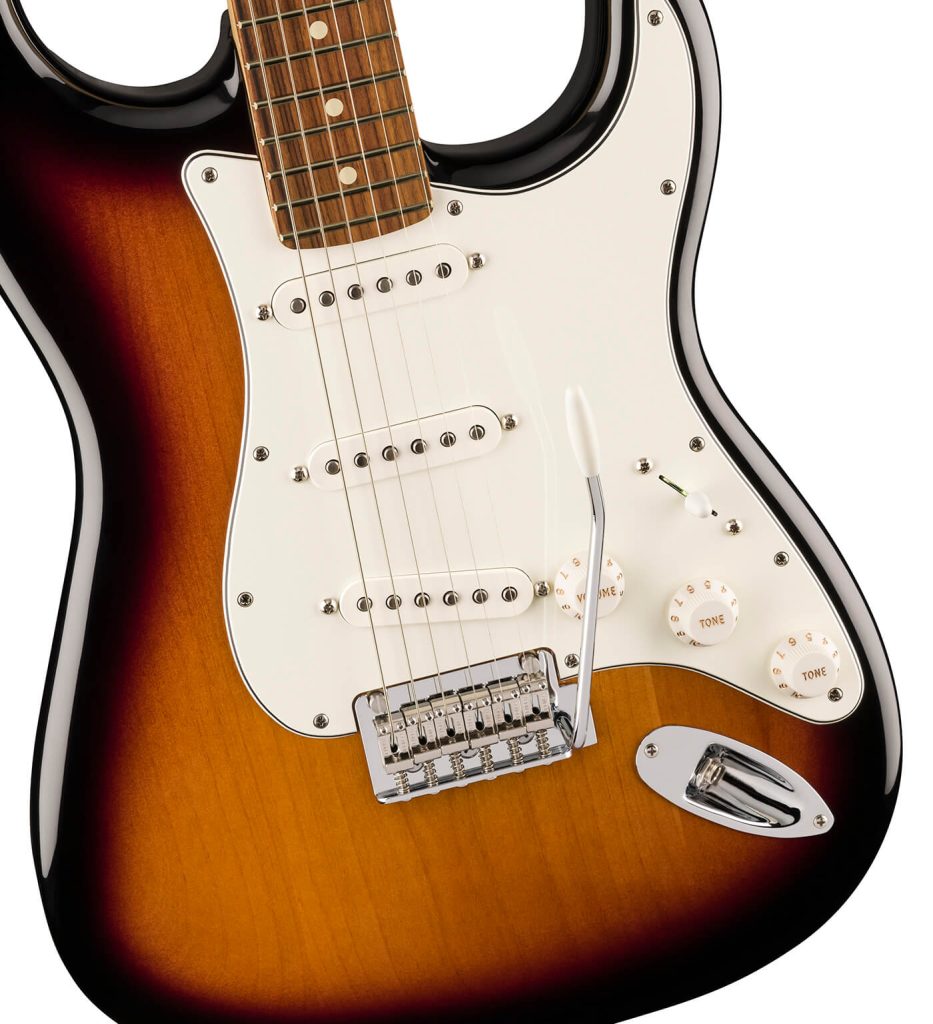
The built-in tremolo system was another feature that attracted players to the Stratocaster, and acts including the Ventures and Beach Boys combined the vibrato on their Strats with Fender reverb to create an iconic surf sound. Perfecting tremolo for the Strat was a priority for Leo Fender, and it was a task that took effort to perfect. He was determined to improve upon designs from his former business partner Doc Kauffman, and Paul Bigsby. That required improved tuning stability, without sacrificing the instrument’s tone, sustain, and playability. In the early ‘50s there weren’t any prototypes to draw from, which resulted in a trial and error process. First Fender devised a system that used a bridge with rollers on each string and a separate tailpiece, so the strings slid over the bridge on the rollers. Leo Fender signed off on the prototype and put it into production. That was the first big error. The initial run of tremolo bridges sounded awful – “like an amplified banjo with no sustain,” according to one description.
The second vibrato bridge, designed in 1953, was a huge improvement. The whole bridge assembly moved with the strings instead of over them. Attached by screws and springs underneath, allowing the bridge to be easily lowered and raised with a tremolo arm that smoothly and cleanly lowered and raised the tone.
In the ‘60s and ‘70s, with the technological developments of amplifier gain and overdrive, distortion, and fuzz pedals, artists that played Stratocasters were able to shape and individualize their sounds with clarity and vision. Abbassi credits this to the instrument’s three-pickup design for enabling artists from numerous genres to fine tune their sound. He says the three single-coil alnico 3 pickups with staggered-height pole pieces were crucial elements for players who wanted to ramp up their sound in search of the right tone.
“A lot of the earlier Strats – and even Strats today – have lower output pickups, and I think low output pickups work very well with overdrive and distortion because you can control that with your amp or with your pedal,” he says. “A Strat gives you a perfect bass clean tone to build upon with overdrive. I also think, again, the transparency of the sound, it’s very expressive and the frets are spaced a little wider than a lot of other instruments from other companies, and I think that lends itself to more precise playing.
“Jimi Hendrix, David Gilmour, Jeff Beck, Ritchie Blackmore, Stevie Ray Vaughan, Andy Gill of Gang of Four, and brother Wayne Kramer of the mighty MC5 have all wielded the Strat in inspirational ways,” says Rage Against the Machine’s Tom Morello. “And my [Signature] Soul Power Strat allowed me to unlock a new era of sound and fury in Audioslave.”
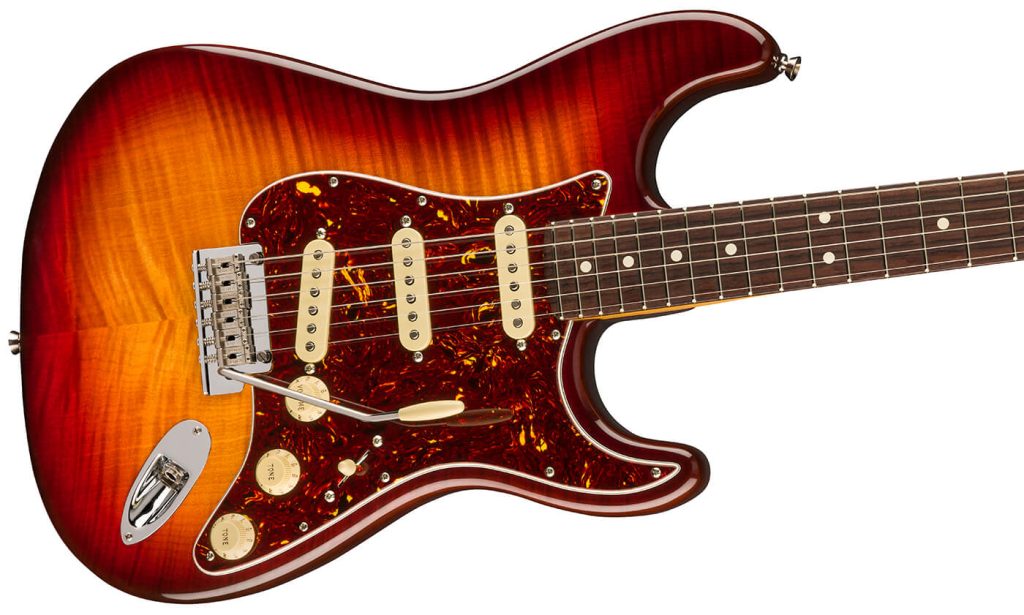
When Fender launched their first line of Strats in October 1954 in tremolo and non-tremolo versions, they thought the instrument would rapidly replace the Telecaster as their top seller, and they hoped the sleek, streamlined guitar would quickly take over the marketplace. That didn’t happen. It would be more than a decade before the Strat first unlocked that “new era of sound and fury” Morello spoke of and became the top-selling guitar as well as one of the most iconic symbols of rock and roll.
Fender’s main problem was that it was too far ahead of the times. The easy customization and futuristic design – which somehow looked more galactic in a guitar than it did in the P-bass – turned off many musicians, who misinterpreted Fender’s visionary thinking as gimmicky and immature for a serious musician. Rock and roll was making a mark with the youth, but the primary early instruments of the genre were piano and saxophone. Guitarists were considered secondary and often played flat-top acoustics or the early hollow body electrics.
“It actually had a slower burn at the very beginning than was expected,” Abbassi says. “Right after it launched, they were still selling many more Teles vs. Strats. It didn’t instantly hit with a huge splash and became the most popular thing. It wasn’t until the advent of television and the event where Buddy Holly was on the ‘Ed Sullivan Show’ that a lot of people got their first look at the Strat and they saw this hip, cool musician playing this incredibly cool looking guitar. And then it kind of built from there, thanks largely to acts like Jimi Hendrix and The Beach Boys, who were playing this cool guitar in very different ways.”
In the years between the Strat’s somewhat disappointing debut and its domination of ‘60s and ‘70s in the hands of Hendrix, Beach Boys, Pete Townshend, David Gilmour, and others, Leo Fender continually upgraded and improved the instrument. His company switched between rounded “C”-shaped necks and pointer “V”-shaped necks, before returning to the “C” shape. They updated the two-color sunburst to three-colors, by adding a reddish hue, and offered customers a range of other colors to choose from. They also replaced the brittle plastic pickguard with multi-ply celluloid guard, changed the pickup magnet from alnico 3 to alnico 5, and adjusted the headstock’s round string retainer to a string tree with a guide for the first and second strings. And, perhaps, most significantly, they switched from ash to alder wood for the body.
“Ash tends to be a little heavier than Alder,” Abbassi says. “Honestly, I think Leo switched to Alder probably for manufacturing and cost reasons, but both Alder and Ash tend to be a little lighter than mahogany, which is what most Gibsons are made out of.”
The Stratocasters released in the early ‘60s weren’t much different than the guitars Fender continues to release today. That said, for a short while, the Jazzmaster, introduced in 1958, was the company’s top-of-the-line electric solidbody. It was pricier than the Strat and appealed to serious jazz, blues, and surf guitarists. However, Fender continued to support the Strat, and launched a creative marketing campaign in the early ‘60s that boosted its public visibility.
“There were cool advertisements in the ‘60s that showed people surfing with their Strat and taking their Strat to the beach,” Abbassi says. “There was one that showed a guy jumping out of a plane holding a Strat. It was a very robust and effective campaign.”
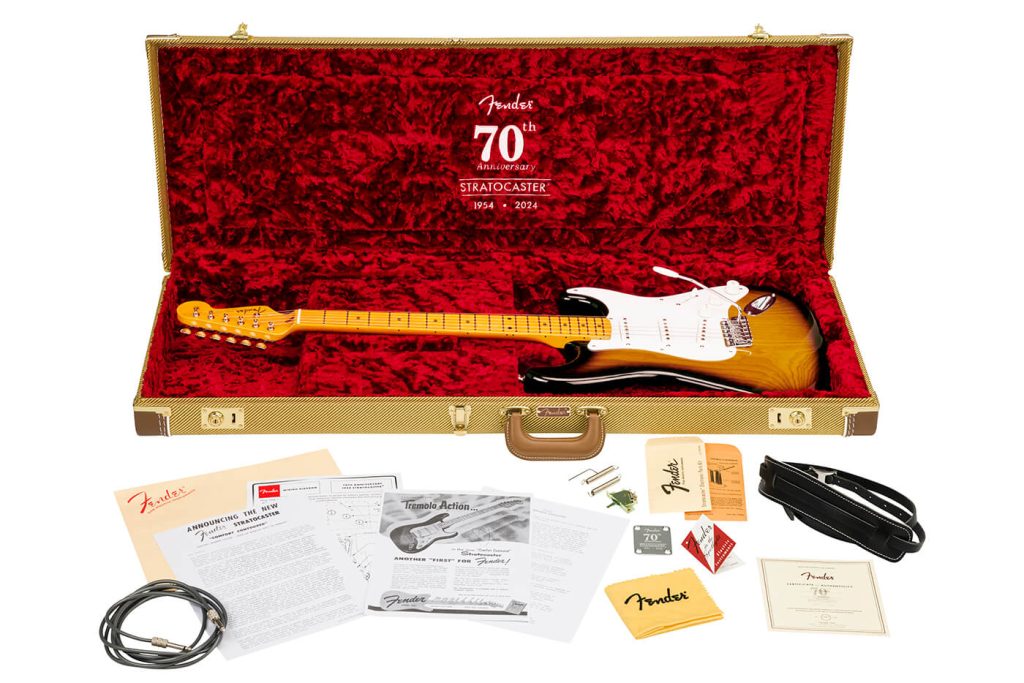
In the early ‘60s, talented Louisianna bluesman George “Buddy” Guy, who favored the look and feel of the Strat, brought the model to his followers, as did California player, Richard Monsour (aka Dick Dale). Ike Turner, who favored the tremolo system of the Strat, made it a staple of his sound a good ten years before Hendrix championed the instrument. Other prominent eclectic players who flaunted their Strats included Pee Wee Crayton, Ritchie Valens, Cal Perkins, Gene Vincent, Johnny Meeks, and Howard Reed.
To a large extent, the explosion of Stratocasters in the ‘50s and ‘60s was limited to American musicians. A trade ban on U.S. goods post-World War II kept Fender guitarist from getting into the eager hands of numerous European musicians. London-based guitarist Brian Rankin (aka Hank Marvin), who played with Cliff Richard’s band saw a photo of Buddy Holly wielding a Strat and told Richard about the cool guitar. Despite the ban, in early 1959, Richard received a Fiesta Red Stratocaster with gold hardware in the mail and gave it to Marvin, who used it for some of his most flamboyant performances. Allegedly, it was the first Strat to arrive on UK shores.
In the years that followed, numerous British guitarists added the Strat to their wish lists. Then, in early 1970, Eric Clapton, who had recently left Cream, and was about to hit the scene with his first solo album started a British Strat invasion; During a trip to U.S., he picked up a bunch of Strats, and when he returned the England, he gave them to his friends, including Pete Townshend and Steve Winwood. From the guitars that were left, he made the legendary Blackie guitar, by Frankensteining a ’56 body, a ’57 neck, and single coil pickups from a third guitar, according to his longtime guitar tech Lee Dickson. That instrument was featured on the cover of his self-titled solo debut, which came out at the end of 1970. Blackie was Clapton’s weapon of choice for years, and the guitar legend played it onstage, notably for his set at Live Aid, and on numerous recordings, including his cover of J.J. Cale’s “Cocaine.”
“The popularity of the Strat really became dominant as it was used on more albums,” Abbassi says. “Musicians of Jimi Hendrix’s stature are key to the popularity of the Strat. He’s probably one of the number one musicians that caused other guitarist to want to have a Strat, and a lot of great players followed.”
The combination of quality craftsmanship, exceptional sound, versatility, and a universally cool design has kept the Stratocaster at the top of the guitar heap, with few alterations, since the ‘70s.
“To this day, it has been used by so many brilliant musicians on so many different recordings, in so many different styles,” Abbassi concludes. “Hits of every decade have a Strat in there.”
